A Double-Edged Sword of Information
Costa Rica, a country celebrated for its rich biodiversity, has over the years made significant efforts to compile vast amounts of data about its flora and fauna, making it easily accessible to the public. While these databases are invaluable for researchers, students, and nature enthusiasts, they have unwittingly become a roadmap for criminal groups with nefarious intentions: trafficking wildlife to cater to the high-demand exotic collectors’ market.
Forensic Biology to the Rescue
John Vargas Fonseca, the head of the Forensic Biology Section of the Judicial Investigation Organization (OIJ), revealed this alarming trend at a press conference on August 30th. This unit specializes in identifying trafficked species and also assists in various environmental investigations.
Digital Platforms: A Boon and Bane
Costa Rica’s initiatives, such as the work done by the National Biodiversity Institute (INBio) and the ongoing efforts of the National Museum, offer a user-friendly platform where anyone can view the existing species in specific regions. “This accessibility is a goldmine for traffickers catering to collectors who wish to preserve ‘soon-to-be extinct’ specimens,” Fonseca noted.
Costa Rica’s Unintended Appeal
The biologist emphasized that Costa Rica’s information infrastructure makes it an attractive hunting ground, especially for insect collectors. Besides, the nation has seen an uptick in the trafficking of species, be it for traditional medicine, aphrodisiacal properties, culinary purposes, mainly targeting the Asian market.
Staggering Statistics: A Wake-Up Call
Recent statistics from the Public Ministry are startling. Reports of wildlife smuggling skyrocketed from 89 cases in 2019 to a whopping 975 in 2020 – a near 1000% increase. Despite efforts to procure more updated figures, as of the publishing date, no recent data was available.
The Uphill Battle Against Environmental Crimes
One of the significant challenges in tackling environmental offenses, as Vargas highlighted, is their high profitability coupled with minimal penalties. For instance, Costa Rica’s Wildlife Conservation Law No. 7317 imposes penalties of fines and prison sentences of less than two years for unauthorized export of flora and fauna.
To put it in perspective, an OIJ operation recovered a box with 10,000 beetles worth approximately $500,000 when sold as crafts. A single butterfly can fetch up to 1,000 euros in Europe. Such hefty profits attract criminal syndicates involved in drug trafficking, money laundering, and even terrorism. Interpol reports suggest environmental crime now ranks as the primary revenue source for international mafias and is the fourth most profitable criminal enterprise globally.
A Plea for Greater Vigilance
It’s not uncommon for authorities to nab foreign nationals attempting to smuggle wildlife in their luggage. Past incidents include a New Zealander caught at Juan Santamaría Airport with live marine mollusks. Furthermore, in June 2022, OIJ raided souvenir shops at the airport and Playas del Coco, where insects and butterflies encased in resin were being sold.

